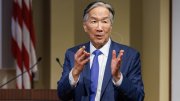Philippe Aghion, Ph.D. ’87, was one of three scholars awarded a Nobel Prize in economics this week for his role in illuminating how the phenomenon known as “creative destruction” drives economic growth.
A professor at the College de France in Paris and at the London School of Economics (and a Harvard faculty member from 2000 to 2015), Aghion coauthored a 1992 paper with Brown University economist Peter Howitt that developed a mathematical model for “creative destruction,” a description of the way new innovations displace old technologies. The term was popularized in the mid-1900s by Austrian economist Joseph Schumpeter, and Aghion and Howitt’s research translated the concept into a formalized theory, showing the mechanism by which creative destruction generates long-term economic growth.
Aghion and Howett also explored the inherent conflicts that arise when companies that sell a dominant technology try to maintain their market position by suppressing new innovation.
In an interview published on the Griffin School of Arts and Sciences website, Aghion offered an example. For many years, he said, Microsoft, Amazon, and Facebook—“superstar firms that initially harnessed the IT revolution so well”—boosted growth in the American economy. “But since 2005,” he said, “growth has been dampened because they became so pervasive that they ended up discouraging new firms.”
Aghion’s work with Howitt describes how economic growth is sustained by a perpetual flow of new companies and innovations challenging old ones. They emphasize the need for governments to regulate market economies to keep this motion in balance.
Aghion and Howitt shared their part of the Nobel Prize with Northwestern University economist Joel Mokyr, who uncovered the historical conditions that made it possible for sustained economic growth through technological innovation to become the norm.









